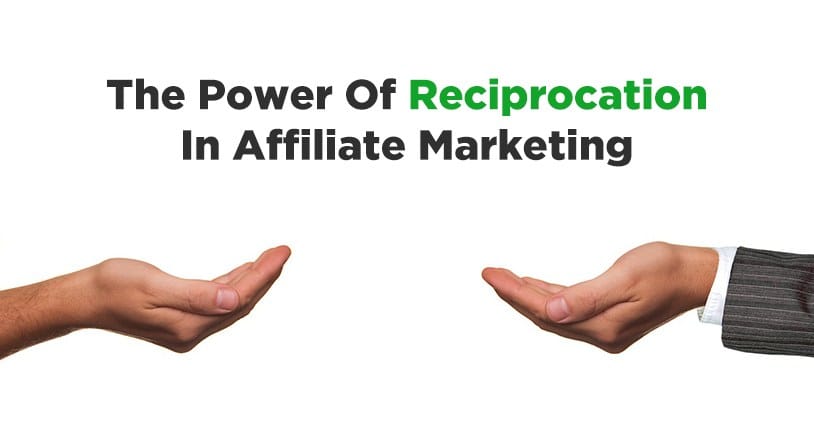Contents

Reciprocation is a very important concept in the world of marketing. That's because understanding it and using it to your advantage can mean unlocking huge sales compared to not using it and getting lackluster results.
A really great book I read recently on the recommendation of Charles Ngo is Ca$hvertising by Drew Whitman.
In it, Whitman talks a lot about the intersection of advertising and persuasion. So much so that he dedicates a whole section to outlining Robert Cialdini's six principles of influence.
Cialdini, if you're not familiar, is considered by many to be the “godfather of influence.” He's the author of Cialdini's Theory of Influence, which is a collection of six principles (actually he added one more in recent times to make it seven) that describe how people can be influenced.
I couldn't help but relate the whole concept back to affiliate marketing and how influence can (and must) be used to make affiliate sales.
While Whitman's book concentrates mostly on advertising and how you can get better results from your ad spend, I think many of the things he talks about can be directly applied to affiliate marketing.
Here, I want to zoom in on just one of the concepts Whitman talks about leveraging called reciprocity.
What Is Reciprocation
Reciprocation is the first of Cialdini's principles.
Almost universally across cultures, humans are trained from a very young age to understand reciprocity. Receiving a gift induces the feeling of wanting to give something back. You feel that you must return the favor.
In affiliate marketing, unfortunately, you're just the middleman, which can make that whole reciprocity thing a bit difficult.
The key to unlocking the power of reciprocity as an affiliate is finding a way to add value. You have to GIVE in order to trigger the principle of reciprocity.
How Reciprocation Works In An Online Setting
As I mentioned, giving is how you trigger reciprocity.
Many businesses do this by giving out freebies, gifts, and samples. I see it in action whenever I walk past our local Boost Juice (a popular juice chain here in Australia). They're always standing out front giving away free sample cups of juice. You take some juice and feel like you should buy one because its polite.
You also see it in action with coupon ads for your local supermarket and magazines with little gifts on the front at the news stand.
So how can you, the affiliate website owner, use it in an online setting?
Well, you can't really give out samples on your website, but you can give something else that is very desirable: information.
What Kind Of Information Should You Give Your Visitors?
I recommend that you pay attention to two things closely:
- Who is coming to your site (describe them by age range, gender, interests, etc.)
- The intention of the visitors who are coming to your website (what are they currently looking to do?)
By analyzing who they are and what their intention is, you can come up with something they might desire.
For example:
- If you're attracting men wanting to grow an awesome beard to your site, give them a guide on the 21 essential beard care and maintenance products.
- If you're attracting middle-aged women who are just starting to learn about yoga, give them a checklist of the 10 basic positions they need to master.
- If you're attracting new parents looking for info on how to start feeding their baby solid food, give them a one-week meal plan prep guide.
- If you're attracting busy parents looking for five-ingredient recipes, give them a checklist of the top seasonal recipes they can make in 15 minutes or less.
As you can see, it's all about identifying who you're serving and giving them something that matches their intent. The best kind of information to give your visitors is the stuff they're immediately interested in.
When Do You Receive?
When you give your information to your visitors, you should make sure you do one very important thing.
Only allow access to it after they give you their email address.
You can do this by using an optin tool like OptinMonster.
By doing this, you have their permission to contact them again, and that's where the relationship starts.
Now you know who you are talking to, you know their desires (based on who they are and what their intent is), and you can keep talking to them and warming them up so they'll be more receptive to your affiliate offers in the future.
I suggest you use a sequence of emails (called an autoresponder campaign) to keep in contact with these people. Tools like Drip make this easy.
An autoresponder campaign will allow you to write a number of emails that go out to these visitors who have opted in for your information over time, making you a familiar face to them.
Now the visitor has received your information, and you've warmed them up by making contact a few times. You're now in a prime position to send them an affiliate offer. Frame it as a recommendation, and you'll be seeing sales in no time.
Recap
So to recap:
- Reciprocation is the act of giving in order to receive something
- You can use Cialdini's principle of reciprocity on your affiliate site
- Information is the best way to GIVE in an online setting
- Get their email in exchange for the information
- Warm up the prospect by sending a number of emails in an autoresponder campaign sequence
- The time is now right to send your affiliate offer and frame it like a personal recommendation for maximum effect


